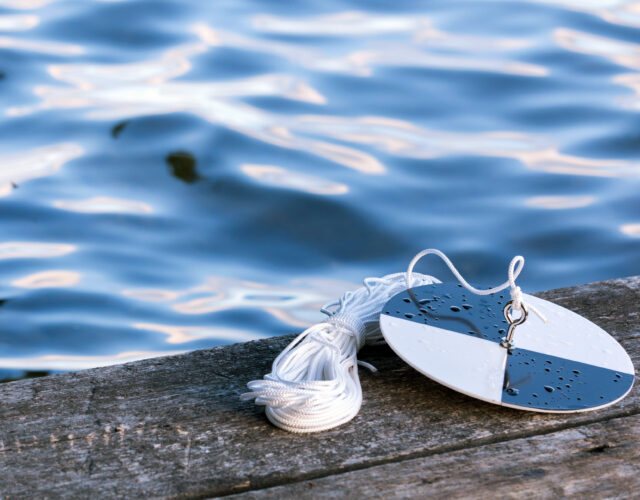Before radar and sonar, before the myriad technologies that allow us to accurately map the ocean, sailors relied on other methods to find their way across the sea. At night they would use the stars as their guide. But when clouds blocked out the stars or fog obscured mariners’ view of the horizon, they would turn their gaze from the sky to the water and a deceptively simple device.
Their tool would eventually be known as a Secchi disk, but in the 17th and 18th centuries sailors knew it by a more common name: a dinner plate. They used this plate—or any convenient bright, white, heavy object on hand—to measure water clarity, otherwise known as turbidity. The turbidity of the water would vary depending on the location of the ship, and such differences meant that turbidity could be used as a rudimentary navigational tool. And the easiest way to measure turbidity? Place a dinner plate in a net, lower it into the water, and note the depth at which the plate stopped reflecting sunlight and faded out of sight.
It wasn’t tried-and-true science, but it had its uses. For instance, a crew trying to keep their ship from drifting as they set course around the Sargasso Sea might use turbidity readings to ensure they were sailing within the bounds of the clearer currents. Or sailors attempting a landing on a particularly foggy day might monitor turbidity changes as they approached the clearer waters of a rocky shoal to avoid running their ship aground.
In 1865 Pope Pius IX decided he needed more accurate measurements of the turbidity of the Mediterranean Sea. His reasons were disputed even at the time—some sources say he wanted to measure water pollution in and around the Mediterranean; others that he wanted more reliable navigational charts; while still others maintained that he simply wanted written proof of the beauty and clarity of the sea’s waters. Whatever the reason, Pius IX wanted turbidity measurements standardized. He tasked Alessandro Cialdi, the commander of the papal navy, with finding a reliable and consistent method of measuring water clarity. Cialdi was familiar with the dinner plate method, but he was no scientist; he would need someone with more experience in experimentation and data collection. And who better to help than a scientist already employed by the Vatican?

Pietro Angelo Secchi was the pope’s astronomer, but he also dabbled in a number of scientific fields and was more than happy to accompany Cialdi on his mission. So off the pair went on the papal yacht, Immacolata Concezione, to map the murkiness of the sea. After experimenting with various shapes, sizes, colors, and other details, the pair ended up with a device very similar to the original dinner plates—a 30-centimeter white disk that could be weighted and lowered into the water by rope. The depth at which the disk disappeared from view would then establish the level of turbidity. By regularly measuring the same spots in different conditions and seasons, sailors could reliably determine average turbidities to use for navigation.
As this standardized method of measuring water clarity slowly caught on, its uses evolved, and it became a tool adopted by environmental monitors. Indeed, water sanitation pioneer George Whipple used Secchi disks in his work, modifying the design in 1899 by adding black quadrants that are now standard.
At face value, turbidity is just a measure of water’s cloudiness or haziness. Yet sailors for centuries were often unknowingly measuring phytoplankton levels. As the first step in the marine food chain, phytoplankton is a vital part of ecosystem health and their levels matter a great deal to biologists and other scientists interested in water quality. The higher the density of phytoplankton, the hazier the water—information that can quickly be measured with a Secchi disk. In fact, the Secchi disk is useful enough that Richard Kirby, an independent marine biologist known as the Plankton Pundit, launched a program in 2013 asking sailors to take turbidity measurements with homemade disks and add their data to an online database that, among other things, can then be used to study ocean transparency and the effects of climate change.

When it comes to drinking water, scientists usually focus on other suspended bodies instead of phytoplankton. “Higher turbidity levels,” according to the EPA, “are often associated with higher levels of disease-causing microorganisms such as viruses, parasites and some bacteria.” It warns that these contaminants “can cause symptoms such as nausea, cramps, diarrhea, and associated headaches.” The primary cause of turbidity in water, the agency states, is soil runoff.
According to Cleveland’s water department, the main point of monitoring the turbidity of drinking water is less the turbidity itself and more the way it reflects how well the water sanitation process is working. Since turbidity is a measure of the suspended solids within water, higher turbidities indicate contaminants that, while not always directly harmful to health, will still affect the taste and smell of the water.
More than 150 years later, Cialdi and Secchi’s modified dinner plates remain essential for measuring turbidity, whether in ponds, lakes, or oceans. The EPA provides instructions for volunteer water monitors who wish to learn how to use Secchi disks and transparency tubes. Despite modern technology, the tried-and-true method of looking at a black and white disk until you no longer see it is still in use. The focus may have shifted from navigating the oceans to navigating the tricky world of climate change, but the simple Secchi disk is here to help.




